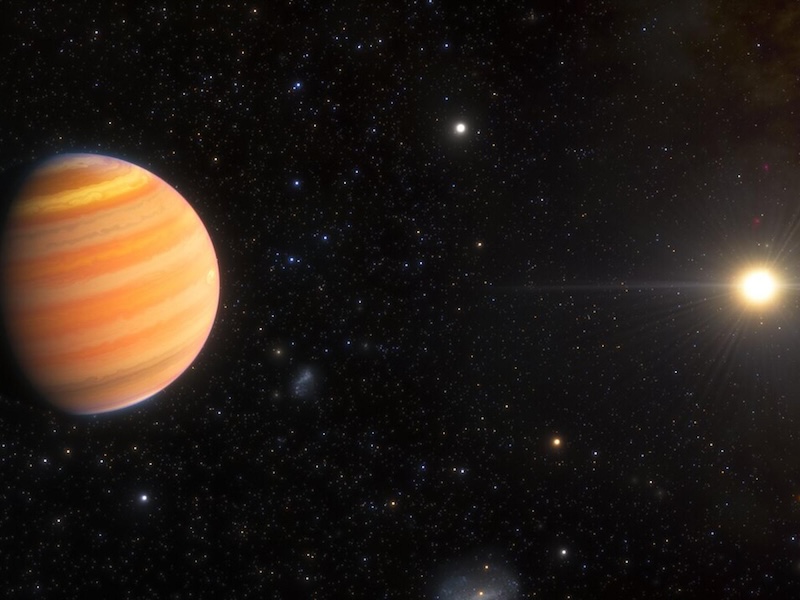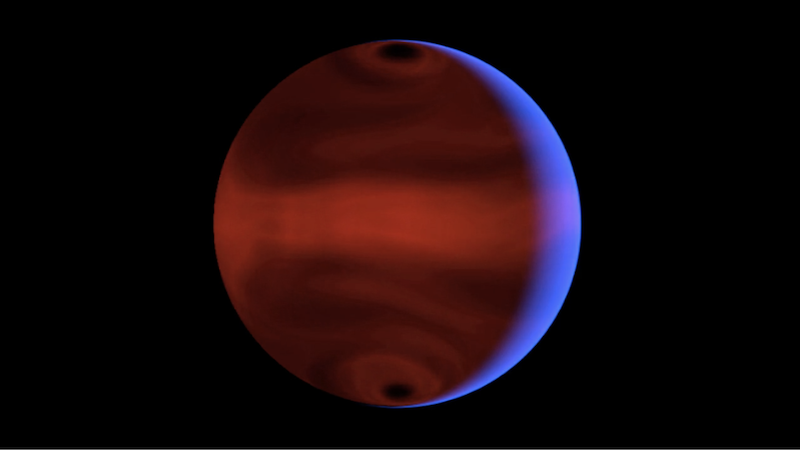Will this ‘hairpin turn’ exoplanet become a hot Jupiter?
Astronomers have found a 'hairpin turn' exoplanet with an extremely elongated orbit. It also orbits its star backward and may eventually become a hot Jupiter.
The post Will this ‘hairpin turn’ exoplanet become a hot Jupiter? first appeared on EarthSky.
- Exoplanet TIC 241249530 has an extremely elongated, cucumber-shaped orbit, making a sharp “hairpin turn” every time it approaches its star.
- The exoplanet also orbits its star backward, another rare phenomenon among observed transiting exoplanets.
- Scientists believe TIC 241249530 may be transitioning into a hot Jupiter, offering insights into planetary migration processes.
Exoplanet with an extreme orbit
We tend to think of planets orbiting their stars in nice, neat circles. But that’s not always true, not even in our own solar system. Now, astronomers have found an exoplanet with a massively stretched-out orbit. A team of astronomers, led by Penn State University, said on July 17, 2024, that the orbit is the most extreme they’ve ever seen among exoplanets that transit their stars. The shape of the orbit looks more like a cucumber than a circle. The ‘hairpin turn’ exoplanet makes a sharp turn every time it approaches the star.
Plus, the planet is orbiting its star backward, something also not often seen. Although the planet is only close to its star for part of its orbit, the observations provide clues as to how hot Jupiter exoplanets form.
The researchers published their peer-reviewed findings about the unusual planet in Nature on July 17, 2024.
The unusual oblong orbit of ‘hairpin turn’ exoplanet TIC 241249530. Video via International Gemini Observatory/ NOIRLab/ NSF/ AURA/ KPNO/ R. Proctor/ J. da Silva/ Spaceengine/ M. Zamani/ ESO/ L. Calçada/ M. Kornmesser/ N. Bartmann/ YouTube.
‘Hairpin turn’ exoplanet has a stretched-out orbit
Astronomers have seen exoplanets with elongated orbits before. But the orbit of this planet – TIC 241249530 – is really stretched out. It looks like a cucumber in shape. So, every time the planet passes closest to its star, it makes a sharp “hairpin turn” of sorts. As co-author Suvrath Mahadevan at Penn State said:
We caught this massive planet making a sharp, hairpin turn during its close passage to its star. Such highly eccentric transiting planets are incredibly rare, and it’s really amazing that we were able to discover the most eccentric one.
Some planets have near-perfect circular orbits. Others are more elongated. But this planet’s orbit is the most extreme seen yet among exoplanets that transit – pass in front of – their star as seen from Earth. Its orbital eccentricity – deviation from a perfect circle – is 0.94. For comparison, the dwarf planet Pluto’s orbit is also highly elongated, but only has an orbital eccentricity of 0.25. Earth’s orbit is much more circular, at only 0.02.
For TIC 241249530, the researchers said its highly eccentric orbit means there would be wild temperature differences. When it’s farthest from its star, temperatures are about like a summer’s day on Earth. But at its closest, it’s scorching hot.
The planet orbits its star about once every six months.
Its orbit is backward, too
Not only is the orbit of the “hairpin turn” exoplanet unusual, but the planet is orbiting its star backward, too. That means it orbits in the direction opposite to the rotation of the star, something else astronomers rarely see.
That, plus its weird elongated orbit, make it a rare find for astronomers.

Will the ‘hairpin turn’ exoplanet become a hot Jupiter?
In addition, the discovery suggests TIC 241249530 may be in the process of becoming a hot Jupiter. Hot Jupiters are gas giant planets that orbit close to their stars, and so, are extremely hot. Scientists think sometimes “normal” Jupiters migrate from highly eccentric orbits toward tighter, more circular orbits around their stars.
Lead author Arvind Gupta at Penn State and NOIRLab said:
While we can’t exactly press rewind and watch the process of planetary migration in real time, this exoplanet serves as a sort of snapshot of the migration process. Planets like this are hard to find and we hope it can help us unravel the hot Jupiter formation story.
Astronomers have discovered many hot Jupiters so far, but they are also looking for planets that will likely become hot Jupiters in the future. TIC 241249530 seems to fit that bill, as Gupta noted:
Astronomers have been searching for exoplanets that are likely precursors to hot Jupiters, or that are intermediate products of the migration process, for more than two decades, so I was very surprised – and excited – to find one.
Detection and characterization of TIC 241249530
The astronomers first found TIC 241249530 using NASA’s Transiting Exoplanet Survey Satellite (TESS) in January 2020. They then further confirmed it with the WIYN 3.5-meter Telescope at the U.S. National Science Foundation (NSF) Kitt Peak National Observatory (KPNO). The NN-EXPLORE Exoplanet and Stellar Speckle Imager (NESSI) on WIYN helped to block out twinkling of the planet’s star caused by Earth’s atmosphere. Next, the researchers used the NEID spectrograph and the Habitable Zone Planet Finder (HPF) spectrograph to analyze the light coming from TIC 241249530.
The analysis of the planet also confirmed it is approximately five times more massive than Jupiter.

New record holder
TIC 241249530 now holds the record for transiting exoplanet with the most eccentric orbit. Previously, HD 80606b held that title.
Jason Wright is a professor of astronomy and astrophysics at Penn State and supervised the new study. He explained:
This is the most eccentric transiting planet known and will prove to be as important as the previous record holder, HD 80606b, which likewise has a wacky orbit highly misaligned with its host star’s spin. These two highly eccentric planets have been “caught in the act” of evolving toward hot Jupiter status. Like HD80606b, this planet is many times Jupiter’s mass, suggesting this channel for forming hot Jupiters might be one only the most massive planets can take.
Wright added:
We’re especially interested in what we can learn about the dynamics of this planet’s atmosphere after it makes one of its scorchingly close passages to its star. Telescopes like NASA’s James Webb Space Telescope have the sensitivity to probe the changes in the atmosphere of this newly discovered exoplanet as it undergoes rapid heating, so there is still much more for the team to learn about the exoplanet.
Scientists are excited about the early results for TIC 241249530 and about NEID overall. Co-author Andrea Lin, a doctoral student at Penn State, said:
It’s so exciting to see such great science coming out of NEID within just a few years of operations. We’re just getting started and I’m looking forward to seeing what we can accomplish in the future.
Bottom line: Astronomers have found a “hairpin turn” exoplanet with an extremely elongated orbit. It also orbits its star backward and may eventually become a hot Jupiter.
Source: A hot-Jupiter progenitor on a super-eccentric retrograde orbit
Read more: The unexpected, exotic characteristics of hot Jupiters
The post Will this ‘hairpin turn’ exoplanet become a hot Jupiter? first appeared on EarthSky.
